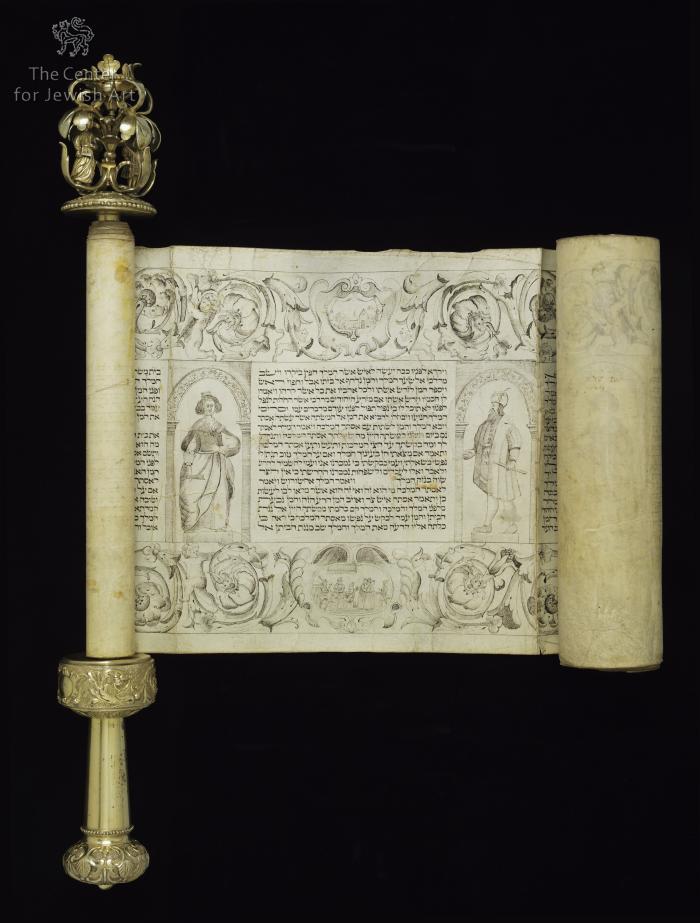Obj. ID: 37632 VAM Michael Judah Léon Esther Scroll, Amsterdam, 1643

The length of the sheets in the scroll: 1) ca. 790 mm, 2) ca. 750 mm, 3) ca. 765 mm, 4) ca. 660 mm, 5) ca. 770 mm, 6) 170 mm (only the part of the sheet filled with decorations).
Dimensions of the selected details in the scroll:
- the opening decoration: ca. 125 mm (width);
- decorations in the upper and lower margins: ca. 64 mm (height);
- figures between the text panels: ca. 100 mm (height);
- frames in the lower margins: 38x58 mm;
- text panel: 128x140 mm;
- an average letter: 4 mm;
- an average letter in col. 15: 6 mm.
The roller: ca. 550 mm (height).
The manuscript is preserved in very good condition although the sheets are crumpled in some places; this causes some damages to the text and decorations.
Some edges of the sheets are not straight.
The lavish decoration in the scroll is executed solely by a pen and brown or black ink. It opens with a decoration composed of tendrils, elaborated leaves, and birds. It is followed by elaborate decoration with a cartouche filled with a Hebrew inscription. It is topped with a helmet and mantling and supported by two angels with trumpets in their hands. Below, an elongated oval panel is filled with the benedictions recited before the reading from the scroll. The Hebrew text of the Book of Esther is inscribed in panels separated by standing figures of Mordecai and Esther. They appear alternately (the first figure in the scroll is Mordecai and Esther is the last one) and each of them appears 9 times in the manuscript. Esther is shown in a long gown with a large collar and laces, holding a closed fan in her hand. Mordecai wears a surcoat and a turban with egret and holds a short scepter (?) in his hand. The borders are embellished with dense foliage, large flowers, figures (resembling wingless putti), and some animals. They all surround cartouches containing land- and seascapes (in the upper margins) and scenes from the Esther story (in the lower margins) that are placed above or below every text panel. The text was copied by Michael Judah Léon.
A belt of silk is sewn underneath a fragment of the first membrane.
The scroll is mounted on a decorative silver-gilt roller with figures of Mordecai and Esther on its upper part. The handle is decorated with a flower pattern.
The Book of Esther in Hebrew with benedictions
The scroll is formed of 6 sheets containing 18 columns of the text with 18 lines, except for col. 15 with 11 lines divided into two half-columns.
The number of the columns of the text per sheet: no. 1 - 2, no. 2 - 4, no. 3 - 4, no. 4 - 3, no. 5 - 4, no. 6 - 1.
The text is inscribed in the Hebrew square Sephardi script with tagim, in brown or black ink, on the flesh side of parchment membranes that are rather thick and stiff. Blank sides of the sheets are not the same - some of them are more smooth and others are more suede.
The letter ח (Es. 1:6) is highlighted by its size and form - it is larger than other letters in the scroll and composed of two elements joined with a roof. The letter ת (Es. 9:29) is enlarged and bolded. Other enlarged and diminished letters are included in col. 15.
The ruling - made with a hardpoint - is well visible. The lines are made only in the text panels. Sometimes, the vertical lines are visible too.
The membranes in the scroll are stitched.
The benedictions are inscribed in the square script. Each benediction starts with an enlarged word ברוך. The benedictions contain a ligature of א and ל letters. The Tetragrammaton is replaced by a composition of two letters י with an elongated and bent flag of ל letter and a leg of א letter.
In the cartouche, being a central part of the opening decoration in the scroll, there is a short inscription in Hebrew:
מיכאל יהודה מחקקי בשנת ה'ת'ג' ליצירה
"Michael Juda, letter-cutter (?), in the year [5]403 [1643] to the creation of the world"
This megillah bears some similarities with the megillot decorated by Shalom ben Mordecai Italia (for his works in the Index see IDs:), however, it cannot be determined if the scroll was adorned him too.
The decoration in the scroll alludes to the copper-engravings (e.g. imitation of the cross-hatching is visible).
Originally, a belt of the fabric must be sewn under the whole first membrane and even under the beginning of the next one, because the seam marks are visible on their upper and lower edges.
Below col. 12 an inscription written in tiny letters is visible.
The shades of the ink differ; the first membrane is decorated and inscribed in brown ink, while for the rest of the scroll black ink was used.
As it is stated by Keen (p. 51 - see "Bibliography"): "Purchased from Elkington & Company for 40₤ on 8 November 1879. (...) This scroll was first received by the Metalwork Department, presumably first acquired for the silver-gilt roller, but it is now in the collection of the National Art Library."
Michael E. Keen, Jewish ritual art in the Victoria and Albert Museum, London 1991, object 34, p. 51.
Catalogue of the Anglo-Jewish historical exhibition, Royal Albert Hall, London 1887, eds. Joseph Jacobs, Lucien Wolf, de-luxe ed., 1888, no. 5, p. 181.
A short description and several images available on http://collections.vam.ac.uk/item/O1364152/megillah-ester-manuscript/ (accessed on 18.12.2020).

